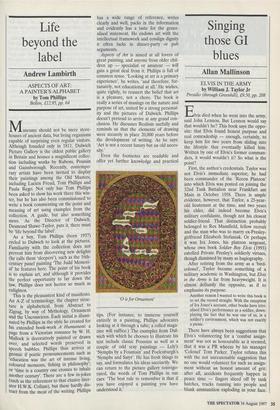Life beyond the label
Andrew Lambirth
ASPECTS OF ART: A PAINTER'S ALPHABET by Tom Phillips Bellew, £12.95, pp. 64
Museums should not be mere store- houses of ancient data, but living organisms capable of surprising even regular visitors. Although founded only in 1811, Dulwich Picture Gallery is the oldest public gallery in Britain and houses a magnificent collec- tion including works by Rubens, Poussin and Gainsborough. Recently, contempo- rary artists have been invited to display their paintings among the Old Masters, including Lucien Freud, Tom Phillips and Paula Rego. Not only has Tom Phillips been asked to show his work there this win- ter, but he has also been commissioned to write a book commenting on the point and meaning of art using examples from the collection. A guide, but also something more. As the Director of Dulwich, Desmond Shawe-Taylor, puts it, there must be 'life beyond the label'. As a boy, Tom Phillips (born 1937) cycled to Dulwich to look at the pictures. Familiarity with the collection does not prevent him from discovering new delights (he calls them `sleepers'), such as the 16th- century panel painting 'The Judd Memori- al' he features here. The point of his book is to explain art, and although it provides the perfect opportunity to lay down the law, Phillips does not hector so much as enlighten. This is the pleasantest kind of manifesto. An A-Z of terminology, the chapter struc- ture is alphabetical, from Abstract to Zigzag, by way of Mythology, Ornament and the Unconscious. Each initial is illumi- nated by Phillips in the style he created for his extended book-work A Humument: a page from a Victorian romance by W. H. Mallock is decoratively painted or drawn over, and selected words preserved in speech bubbles. Phillips thus arrives at gnomic if poetic pronouncements such as `education was the art of intense living, coloured moments, fishing in philosophy'; or 'time is a country one crosses to inhale another century'. There are a few in-jokes (such as the references to that elusive liter- ator H.W.K. CoIlam), but these hardly dis- tract from the meat of the writing. Phillips has a wide range of reference, writes clearly and well, packs in the information and evidently has a taste for the gener- alised statement. He endows art with the intellectual framework and condign dignity it often lacks in dinner-party or pub arguments.
Aspects of Art is aimed at all lovers of great painting, and anyone from older chil- dren up — specialist or amateur — will gain a great deal from it. Phillips is full of common sense. 'Looking at art is a primary experience', he writes, 'and therefore, for- tunately, not educational at all.' He wishes, quite rightly, to reassert the belief that art is a pleasure, not a chore. The book is really a series of musings on the nature and purpose of art, united by a strong personal- ity and the pictures of Dulwich. Phillips doesn't pretend to arrive at any grand con- clusion. He discusses Realism usefully and reminds us that the elements of drawing were securely in place 20,000 years before the development of writing. As he says: `Art is not a recent luxury but an old neces- sity.'
Even the footnotes are readable and offer yet further knowledge and practical `0 is for Ornament' tips. (For instance, to immerse yourself entirely in a painting, Phillips advocates looking at it through a tube; a rolled maga- zine will suffice.) The examples from Dul- wich with which he chooses to illustrate his text include classic Poussins as well as a couple of odd sexy paintings — Lely's `Nymphs by a Fountain' and Poelenburgh's `Nymphs and Satyr'. He has fresh things to say, and formulates his ideas succinctly. We can return to the picture gallery reinvigo- rated, the words of Tom Phillips in our ears: 'The best rule to remember is that if you have enjoyed a painting you have understood it.'


























































 Previous page
Previous page